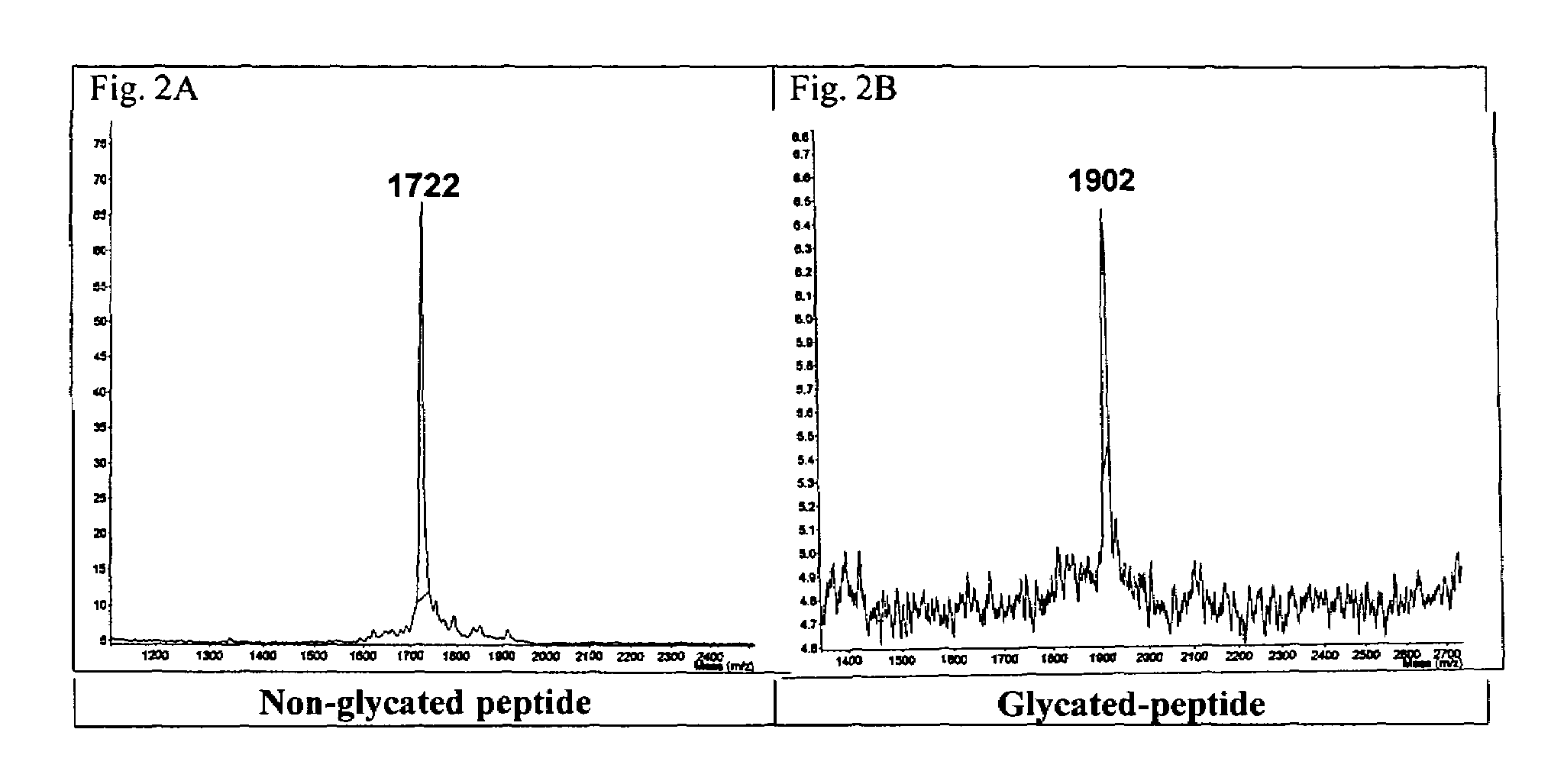Anti-glycated CD59 antibodies and uses thereof
a technology of cd59 and antibodies, which is applied in the field of antiglycated cd59 antibodies, can solve the problems that diabetes mellitus is a leading cause of morbidity and mortality in the adult population, and achieve the effect of facilitating analysis and reducing the level of glycation of cd59
- Summary
- Abstract
- Description
- Claims
- Application Information
AI Technical Summary
Benefits of technology
Problems solved by technology
Method used
Image
Examples
example 1
Generation of Anti-glycated Human CD59 Monoclonal Antibodies
Introduction
[0141]The following procedures were utilized to produce an anti-glycated CD59 specific monoclonal antibody.
Methods
Antigen Production
[0142]The immunogen utilized was a 14 amino acid peptide that encompasses the glycation motif K41-H44 of human CD59. The peptide sequence used was:[0143]Relative residue in the whole CD59 protein
[0144]
(SEQ ID NO:3)50 49 48 47 46 45 44 43 42 41 40 39 38 37 C D N F N A H E F K* W A K N-NH214 13 12 11 10 9 8 7 6 5 4 3 2 1[0145]Relative residue in the peptide
[0146]Because the peptide contains two lysine residues but only one lysine (K*, corresponding to the K41 in the human CD59 protein) is to be glycated, we avoided exposure of the whole peptide to glucose by synthesizing the peptide using a pre-glycated lysine (glucocytol-lysine) for attachment to the peptide structure in the desired position (K5 in the peptide; equivalent to K41 in the whole protein; hereafter ...
example 2
[0175]Experiments were performed to investigate the detection of glycated CD59, the complement regulatory protein that inhibits formation of the MAC. The glycated form of CD59 is inhibited by glycation.
Methods
[0176]An antibody was generated that would recognize the glycated form of human CD59 but not the non-glycated form nor other glycated proteins. To raise this antibody a peptide was synthesized that encompassed the glycation site formed by amino acid residues lysine 41 and histidine 44. The peptide contained a glycated lysine (Kglu) in position 41 and two cysteine residues were replaced by alanine residues to avoid formation of disulfide bridges. The peptide (termed CD5936-49-K41(glu)) was synthesized by solid phase methodology, purified by affinity chromatography and the structure of the purified synthetic peptide confirmed by mass spectrometry.
[0177]Two rabbits were immunized with the human CD5936-49-K41(glu) peptide and the antibody titer detected by ELISA using the same pept...
example 3
[0187]Experiments were performed to detect levels of glycated and nonglycated CD59 in saliva samples. Results indicated that the methods of assessing levels of glycated and non-glycated CD59 could be used for tissues and fluids other than urine and blood, such as saliva, in addition to being used for tissues, urine, and blood samples.
Methods
[0188]Each experiment described below herein involved the detection of glycated CD59, the complement regulatory protein that inhibits formation of the MAC. The initial step in the experiments included the generation of an antibody that recognizes the glycated form of human CD59 but does not recognize the non-glycated form or other glycated proteins. To raise this antibody a peptide was synthesized encompassing the glycation site formed by amino acid residues lysine 41 and histidine 44 and containing a glycated lysine (Kglu) in position 41. In addition, two cysteine residues in the peptide were replaced by alanine residues to avoid formation of di...
PUM
| Property | Measurement | Unit |
|---|---|---|
| temperatures | aaaaa | aaaaa |
| time | aaaaa | aaaaa |
| conformational epitope | aaaaa | aaaaa |
Abstract
Description
Claims
Application Information
 Login to View More
Login to View More - R&D
- Intellectual Property
- Life Sciences
- Materials
- Tech Scout
- Unparalleled Data Quality
- Higher Quality Content
- 60% Fewer Hallucinations
Browse by: Latest US Patents, China's latest patents, Technical Efficacy Thesaurus, Application Domain, Technology Topic, Popular Technical Reports.
© 2025 PatSnap. All rights reserved.Legal|Privacy policy|Modern Slavery Act Transparency Statement|Sitemap|About US| Contact US: help@patsnap.com



